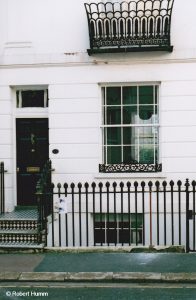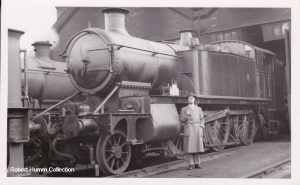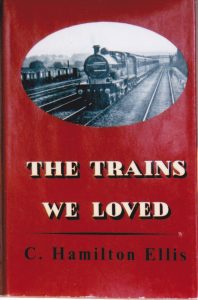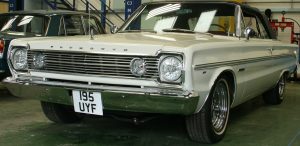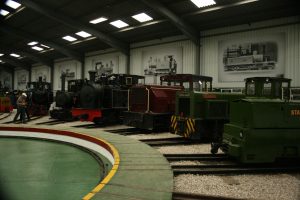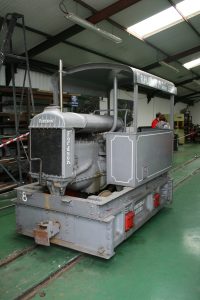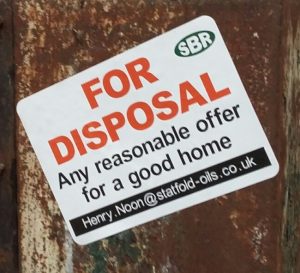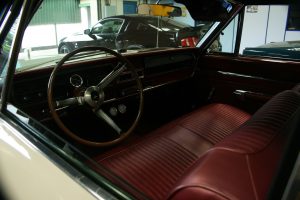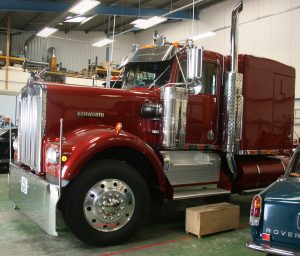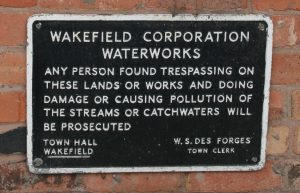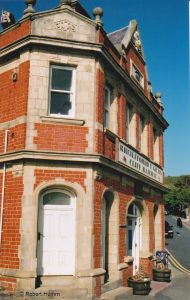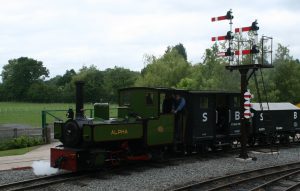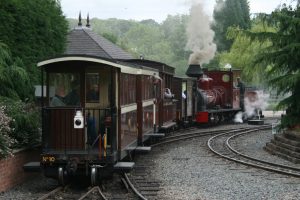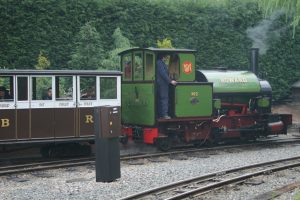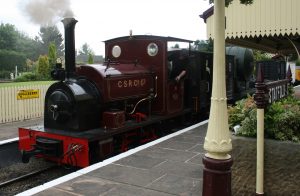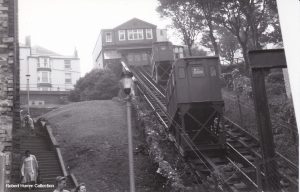The postwar Railway Magazine carried nine more of Hamilton Ellis’s colour plates though by then most of his work was reserved for his own books , or those of other authors that he favoured, or private clients. Painting is what he enjoyed most, and, although his early work was done largely for pleasure, in later years he regarded himself primarily as a commercial artist, not a writer. He had a family to provide for and soon learnt that the potential earnings from writing railway history rarely justified the time spent on research. Painting, he found, was more rewarding both financially and in the giving of personal satisfaction.

“Up Express Approaching Ely In 1914” was perhaps the best of Ellis’s 1950s paintings for the Railway Magazine. This one appeared in the July 1955 issue.
About the time he left Modern Transport in the late 1940s Ellis became the sole beneficiary of a family trust fund. Although apparently not large it gave him a degree of independence from continuous paid employment. In the words of his son “he worked for others where necessary, and wrote or painted full time when he wished.” All the same it was necessary to be careful with money and he himself once recorded a remark by his bank manager: “Painting trains seems a hazardous way to earn a living, Mr Ellis.”
One of the spells of employment was as theme convenor for the maritime exhibits – his second love after railways was ships (and airships) – during 1949 to 1951 for the Festival Of Britain. In the early 1960s Ellis was employed by the BR Eastern Region Publicity Department to feed favourable stories and feature articles to the press. From time to time he took part in publicity promotions such as the ER/Ian Allan Great Eastern Progress Chasers programme for boys. That all came to an end with the arrival of Dr Beeching, who tended to look askance at the proliferation of non-revenue earning activities by the Regions.
 Lecturing was part of the Liverpool Street job. Peter Coghill, then at school in Devon, remembers inviting him to talk to his railway society on the Pullman Car Company. Ellis thought that this would not go down well with Eastern Region and replied “If you would take an alternative subject which has my superior officer’s blessing Wednesday would be alright.” So Grenville College got a talk instead on the Great Eastern Railway, accompanied by a Claud Hamilton splasher casting “which looks quite toney on the lecturer’s table.”
Lecturing was part of the Liverpool Street job. Peter Coghill, then at school in Devon, remembers inviting him to talk to his railway society on the Pullman Car Company. Ellis thought that this would not go down well with Eastern Region and replied “If you would take an alternative subject which has my superior officer’s blessing Wednesday would be alright.” So Grenville College got a talk instead on the Great Eastern Railway, accompanied by a Claud Hamilton splasher casting “which looks quite toney on the lecturer’s table.”
To aid recognition on arrival, Ellis gave a delightful pen portrait: “I am 54, 5ft 8ins, wear horn-rimmed spectacles, and have a short grey beard. A large Victorian watch-chain adorns my waistcoat-part; in fact I might be likened to a London & South Western Officer in the reign of Edward VII.”
It was George Dow, then Chief Public Relations & Publicity Officer of BR London Midland Region, who in 1951 gave Ellis his first major art commission, a group of 24 paintings to be reproduced as carriage compartment prints, Given the generic title of Travel In, the series was something of a breakthrough. Carriage prints were nothing new, but before then had been either sepia photographs of holiday resorts and beauty spots, or promotional material for rail travel by well-known commercial studios.
Their subject matter chosen by Dow personally, the Travel In prints showed the development of locomotives and trains of the LMSR constituent companies at five-year intervals between 1835 and 1920, and portrayed in classic Ellis style. Today, as with all carriage prints, they are highly collectable. For many years the original paintings adorned George Dow’s office and today are at the National Railway Museum
Further public recognition as a painter came with a one-man show at the Museum Of Transport at Clapham, and further shows in the 1970s at the Portal Gallery in Mayfair. One of Ellis’s early private patrons was Peter Allen, author, explorer of remote railways, collector of note, and rapidly heading towards the chairmanship of Britain’s largest company, Imperial Chemical Industries. It is significant that Ellis’s finest painting, a colourful pre-grouping scene at Newport, appeared on the jacket of Allen’s Rails In The Isle Of Wight.
Another patron was Professor David Dilks, who recalls a spur-of-the-moment purchase of one of the exhibits at the first Portal show, of Royal Scot Lancashire Witch near Harthope. Later Professor Dilks commissioned Ellis to paint the Shropshire & Montgomeryshire station at Shrewsbury Abbey, a picture that later appeared as the centre spread in The Railway Magazine of October 1976.
Of Ellis’s technical proficiency as a locomotive illustrator there is no doubt. His ability to capture ornate (and sometimes elusive) Victorian liveries and engineering detail is generally held in high regard, though few would rank him alongside Terence Cuneo, David Shepherd or Philip Hawkins in capturing the energy and spirit of the railway age. In other words his was not Great Art. That is unlikely to have bothered him: his legacy is a vast permanent record – perhaps four or five hundred paintings and as many again monochrome sketches – of how the railways looked in their great days. No other railway painter has achieved such an output.
There are also divergent opinions about the figures that appear in most of the paintings, those entities that one writer has unkindly called The Woodentops – the ramrod straight footplatemen, the demure courting couples by the lineside, the attentive paterfamilias ushering his wife into a first-class compartment. The present writer believes that it is possible to take a more charitable view and at the same time sympathise with the artist’s predicament.
His main purpose was to show locomotives and trains in detail, yet he was aware that a succession of unalleviated three-quarter front views can become tedious for the viewer. The lineside figures add variety without detracting from the main subject. We must also remember that Victorian and Edwardian society was highly formal by today’s standards. Gravity and seemliness were the watchword for those who ruled all the oceans and a quarter of the world’s population. It might also be added that Ellis’s stylised depictions have an honourable precedent in the popular American 19th century Currier & Ives prints, or the naive traditional decoration of canal narrowboats.
To be concluded





